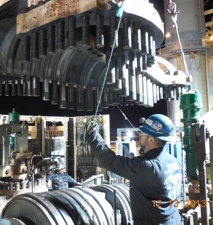Overhead Loads
 A young construction worker was killed the same day his wife was coming home from the hospital with their first child. How did this occur? A crane was transporting a heavy, bulky section six or seven feet in the air to clear other objects. The load was guided by tag lines which were used by all of the workers except this young man. Although warned by his foreman to use the line, he didn’t. A lifting pad gave way and he was killed instantly.
A young construction worker was killed the same day his wife was coming home from the hospital with their first child. How did this occur? A crane was transporting a heavy, bulky section six or seven feet in the air to clear other objects. The load was guided by tag lines which were used by all of the workers except this young man. Although warned by his foreman to use the line, he didn’t. A lifting pad gave way and he was killed instantly.
Let’s face it, our job is dangerous within itself – we don’t need Murphy’s Law in the mix as well. Be aware of the load at all times, no matter how large or small it is. Remind yourself of this slogan the next time a load is lifted – “IF IT’S IN THE AIR, IT’S DANGEROUS”.
Let’s review some of the rules that can help keep us from getting injured by failing loads:
- A load that can be carried close to the ground can be stabilized by a person at each end. These individuals must stay in the clear at all times, and the ground surface must be unobstructed and reasonably level.
- Taglines should always be used where needed and definitely where the load is to be carried more than five feet above the ground. In some cases, ten-foot taglines should be used to guide loads being raised and lowered, rather than using extremely long lines that drag around the job and can snag on something.
- On all jobs, only one person, generally the lead individual, should give signals to the crane operator. If you are assigned the job of directing the crane, follow these basic rules:
- Always use standard hand signals to direct the crane operator.
- Stand in the clear and place yourself where the operator can plainly see you and you can see the operator.
- If you can’t see the load and another person is signaling to you, be sure everyone is in the clear before you give the signal to the operator. Remember, it takes time to relay signals.
- Never permit a load to be lowered, raised, or swung over a worker’s head or an occupied building. If the operator can see the load, it’s the operator’s responsibility — without exception — to see that this rule is followed.
REMEMBER …..”If it’s in the air, it’s dangerous.”
